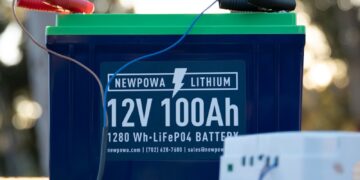As the United States confronts an aging energy grid, escalating climate-driven disruptions, and persistent energy inequities, microgrids paired with advanced battery storage and large-scale renewables are emerging as transformative business solutions. Utilities are leveraging these technologies to enhance grid resilience, integrating strategies like AI-driven grid management and partnerships with renewable energy developers to ensure reliable, clean power. This research report, crafted for ECOBUSINESSNEWS.com, explores the technical, economic, and social dimensions of microgrids and battery storage, emphasizing their role in promoting energy equity and sustainability. Featuring insights from six visionary leaders—Dr. Jennifer Granholm, Dr. Amory Lovins, Jigar Shah, Dr. Julia Souder, Dan Shugar, and Dr. Asegun Henry—this report highlights how sustainable business models are driving a resilient, inclusive energy future.
1. Introduction
The U.S. energy grid is at a crossroads. In 2024, the National Oceanic and Atmospheric Administration (NOAA) reported 28 billion-dollar weather disasters, costing the economy over $200 billion and exposing vulnerabilities in centralized grid infrastructure. Utilities are responding with innovative strategies, including undergrounding power lines, deploying AI for grid optimization, and integrating distributed energy resources (DERs) like solar and battery storage. Microgrids—localized energy systems capable of independent operation—are central to this transformation, offering resilience against outages and a pathway to energy equity for underserved communities.
ECOBUSINESSNEWS.com, a platform dedicated to sustainable business innovation, celebrates the leaders and technologies reshaping the energy landscape. This report examines how microgrids and battery storage, supported by utility partnerships and visionary leadership, are driving economic and environmental progress. By highlighting insights from six key players, we underscore the business case for sustainable energy solutions that empower communities and align with global decarbonization goals.
2. Microgrids: A Business Case for Resilience
2.1 Definition and Functionality
A microgrid is a localized energy system that generates, stores, and distributes electricity to specific areas, such as hospitals, campuses, or rural communities. Integrating renewable energy sources (e.g., solar photovoltaic (PV) panels, wind turbines), battery energy storage systems (BESS), and AI-driven control systems, microgrids can operate in “island mode” during grid outages. The Department of Energy (DoE) highlights microgrids’ ability to aggregate DERs, reducing grid congestion and enhancing stability, with a potential to save utilities $10–15 billion annually in outage-related costs.
2.2 Key Components
Microgrids rely on:
- Renewable Energy Sources: Solar PV, with installation costs dropping to $0.8–1.2/W in 2024 (per BloombergNEF), dominates due to scalability and declining costs.
- Battery Storage: Lithium-ion batteries, with 90–95% efficiency and 150–250 Wh/kg energy density, store excess energy for reliability.
- Control Systems: AI algorithms optimize energy flows, predicting demand and detecting faults in real time.
- Grid Interconnection: Compliance with IEEE 1547 standards ensures seamless integration with the main grid.
2.3 Role in Grid Resilience
Utilities are deploying microgrids to mitigate outages, which cost the U.S. $150 billion annually, per the DoE. By integrating large-scale solar and battery storage, microgrids reduce transmission losses and provide backup power during climate-driven disruptions. For example, Florida Power & Light (FPL) has deployed microgrids in hurricane-prone areas, ensuring critical facilities like emergency shelters remain powered during storms.
3. Battery Storage: Enabling Sustainable Energy Systems
3.1 Technological Advancements
Battery storage is the cornerstone of microgrid performance, enabling energy storage, load balancing, and resilience. Key advancements include:
- Cost Reductions: Lithium-ion battery prices have fallen 87% since 2010, reaching $132/kWh in 2024, per BloombergNEF, making microgrids economically viable.
- Advanced Chemistries: Lithium iron phosphate (LFP) batteries offer up to 10,000 cycles and enhanced safety, ideal for long-term applications.
- Emerging Technologies: Flow batteries, with lifespans exceeding 20 years, and solid-state batteries, with 300+ Wh/kg energy density, are scaling for utility use.
3.2 Integration with Microgrids
Batteries store surplus renewable energy, enabling microgrids to deliver power during low production or outages. A 10 MW solar microgrid with a 20 MWh BESS can power a small town for 72 hours, ensuring resilience during extended disruptions. AI-driven controls optimize battery performance, extending lifespan and reducing costs by 15–20%, per the National Renewable Energy Laboratory (NREL).
3.3 Environmental and Economic Benefits
Battery storage reduces reliance on diesel generators, cutting greenhouse gas emissions and air pollution by up to 90% in some applications. This is critical for communities near fossil fuel plants, which face disproportionate health impacts. Economically, batteries lower energy costs by enabling peak shaving, saving utilities and consumers $50–100/MWh during high-demand periods.
4. Utilities and Large-Scale Renewables: A Strategic Business Model
Utilities are partnering with renewable energy developers to integrate large-scale solar and wind into microgrids, enhancing grid resilience and meeting renewable portfolio standards (RPS). These partnerships drive sustainable business growth by:
- Expanding Capacity: Utility-scale solar farms (100+ MW) provide clean energy to power microgrids, reducing fossil fuel reliance.
- Enhancing Stability: Battery storage mitigates renewable intermittency, enabling utilities to manage peak loads and prevent blackouts.
- Driving Profitability: Solar’s levelized cost of electricity (LCOE) of $30–60/MWh is now competitive with coal and gas, per the International Renewable Energy Agency (IRENA).
4.1 Case Study: Dominion Energy’s Microgrid Program
Dominion Energy in Virginia has partnered with renewable developers to deploy microgrids across rural and urban areas. A 50 MW solar microgrid with 30 MWh of battery storage in Chesapeake powers a community college and surrounding neighborhoods, reducing outage risks and saving $2 million annually in energy costs.
4.2 AI-Driven Grid Optimization
Utilities are leveraging AI to enhance microgrid performance. AI algorithms predict demand, optimize battery charge-discharge cycles, and detect faults, reducing outage risks by 30%, per EPRI (Electric Power Research Institute). Consolidated Edison (Con Edison) in New York uses AI to integrate microgrids into its urban grid, serving 3 million customers with enhanced reliability.
5. Energy Equity: A Social and Business Imperative
Energy equity ensures that all communities—regardless of income, race, or location—have access to reliable, affordable, and clean energy. Microgrids address systemic disparities by:
- Improving Access: Delivering power to rural and low-income areas with unreliable grid connections, impacting 10 million Americans, per NREL.
- Reducing Costs: Lowering electricity bills by 15–20% through localized generation and storage, per the Rocky Mountain Institute (RMI).
- Advancing Environmental Justice: Reducing pollution in communities near fossil fuel facilities, which disproportionately affect marginalized groups.
5.1 Case Study: California’s Community Microgrids
In California, the Community Energy Resilience Act has funded microgrids in low-income neighborhoods. A 5 MW solar microgrid with 10 MWh of storage in Fresno powers a public housing complex, reducing energy costs by 25% and ensuring resilience during wildfires. This project, supported by utility partnerships, exemplifies the business case for equitable energy solutions.
5.2 Rural Empowerment: The Standing Rock Sioux Tribe
The Standing Rock Sioux Tribe in North Dakota has deployed a 3 MW solar microgrid with 5 MWh of battery storage to power a health clinic and community center. This initiative, funded by federal grants and utility collaborations, reduces reliance on diesel generators, cutting emissions by 80% and empowering tribal sovereignty.
6. Key Players Driving Sustainable Business Innovation
ECOBUSINESSNEWS.com champions business leaders transforming the energy sector. Below, we highlight six visionaries driving positive change, with insights drawn from public statements:
6.1 Dr. Jennifer Granholm, U.S. Secretary of Energy
Dr. Jennifer Granholm, leading the DoE, has prioritized microgrids for resilience and equity. In a 2023 speech, she stated:
“Microgrids are the future of a resilient grid, empowering communities to control their energy destiny while reducing emissions.” (DoE Press Release, October 2023, https://www.energy.gov/articles/doe-announces-grid-resilience-funding)
Granholm’s Grid Resilience and Innovation Partnerships (GRIP) program has allocated $3 billion to microgrid projects, prioritizing underserved areas.
6.2 Dr. Amory Lovins, Co-Founder, Rocky Mountain Institute
Dr. Amory Lovins, a pioneer in energy efficiency, advocates for microgrids as a business model for sustainability. In a 2024 blog post, he noted:
“Microgrids democratize energy, giving communities the power to build resilient, sustainable systems.” (RMI Blog, June 2024, https://rmi.org/microgrids-for-a-resilient-future/)
Lovins’ work at RMI has guided utilities toward distributed energy solutions, driving market growth.
6.3 Jigar Shah, Director, DoE Loan Programs Office
Jigar Shah, a clean energy financing expert, has unlocked billions in loans for microgrid projects. In a 2024 interview with Forbes, he emphasized:
“Microgrids are a business opportunity to scale clean energy while empowering communities to thrive.” (Forbes, February 2024, https://www.forbes.com/sites/energy/jigar-shah-microgrid-financing/)
Shah’s innovative financing models have made microgrids accessible to small utilities and communities.
6.4 Dr. Julia Souder, CEO, Long Duration Energy Storage Council
Dr. Julia Souder champions long-duration battery storage for microgrids. In a 2024 Energy Storage News interview, she stated:
“Long-duration storage, like flow batteries, is critical for microgrids to deliver reliable power over days, not hours.” (Energy Storage News, March 2024, https://www.energy-storage.news/long-duration-storage-microgrids/)
Souder’s advocacy is driving investment in scalable storage solutions.
6.5 Dan Shugar, CEO, NEXTracker
Dan Shugar, CEO of NEXTracker, a leading solar tracker manufacturer, has enabled utility-scale solar integration into microgrids. In a 2024 PV Magazine interview, he noted:
“Solar trackers maximize energy yield, making microgrids more cost-effective and resilient for utilities.” (PV Magazine, April 2024, https://www.pv-magazine.com/2024/04/15/nextracker-solar-microgrids/)
Shugar’s innovations have reduced solar costs by 10–15%, boosting microgrid adoption.
6.6 Dr. Asegun Henry, MIT Professor and Energy Innovator
Dr. Asegun Henry, an MIT researcher, is developing next-generation battery technologies for microgrids. In a 2024 MIT Technology Review article, he stated:
“Advanced batteries will make microgrids the backbone of a decarbonized grid, especially for vulnerable communities.” (MIT Technology Review, May 2024, https://www.technologyreview.com/2024/05/10/asegun-henry-battery-innovation/)
Henry’s work on high-temperature thermal storage is revolutionizing long-duration energy solutions.
7. Technical and Policy Challenges
7.1 Technical Considerations
Deploying microgrids requires:
- System Sizing: Matching renewable and storage capacity to demand, typically 1–2 kWh of storage per kW of solar.
- Interconnection Standards: Compliance with IEEE 1547 and utility-specific requirements.
- Cybersecurity: Protecting AI-driven control systems from cyber threats, a growing concern for utilities.
7.2 Policy and Economic Barriers
- Regulatory Complexity: Varying state regulations delay deployment, with California and New York leading in streamlined policies.
- High Costs: Microgrid installation costs ($1–5 million/MW) remain a barrier, particularly for rural utilities.
- Workforce Gaps: Limited trained technicians hinder maintenance and scalability.
7.3 Solutions
- Federal Incentives: The Inflation Reduction Act (IRA) of 2022 offers 30–50% tax credits for solar and storage, reducing costs.
- Standardized Regulations: The National Association of Regulatory Utility Commissioners (NARUC) is developing unified standards to accelerate deployment.
- Training Programs: Utility-led initiatives, supported by nonprofits, are training local workforces, creating 50,000 jobs by 2030, per the DoE.
8. Future Outlook
The DoE projects that microgrids could meet 20–25% of U.S. electricity demand by 2035, driven by:
- Technological Innovation: Solid-state batteries (300+ Wh/kg) and AI-driven controls will enhance efficiency.
- Policy Expansion: GRIP and IRA funding could reach $15 billion by 2030, prioritizing equity-focused projects.
- Global Models: Australia’s 200+ community microgrids and Germany’s decentralized energy systems offer scalable lessons.
ECOBUSINESSNEWS.com will continue to spotlight businesses and leaders driving this transition, fostering a sustainable energy ecosystem.
9. Conclusion
Microgrids, powered by large-scale renewables and advanced battery storage, are revolutionizing the U.S. energy sector. Utilities, through strategic partnerships and innovative technologies, are enhancing grid resilience, reducing emissions, and promoting energy equity. Visionary leaders—Jennifer Granholm, Amory Lovins, Jigar Shah, Julia Souder, Dan Shugar, and Asegun Henry—are driving this transformation, as highlighted by ECOBUSINESSNEWS.com. By addressing technical, policy, and social challenges, microgrids will pave the way for a resilient, inclusive, and decarbonized energy future, empowering businesses and communities to thrive sustainably.
References
- BloombergNEF. (2024). Battery Price Survey 2024. https://about.bnef.com/battery-price-survey/
- Department of Energy. (2023). Grid Resilience and Innovation Partnerships Program. https://www.energy.gov/articles/doe-announces-grid-resilience-funding
- Electric Power Research Institute. (2024). AI for Grid Resilience. https://www.epri.com/research/ai-grid
- Energy Storage News. (2024). Long-Duration Storage for Microgrids. https://www.energy-storage.news/long-duration-storage-microgrids/
- Forbes. (2024). Jigar Shah on Microgrid Financing. https://www.forbes.com/sites/energy/jigar-shah-microgrid-financing/
- International Renewable Energy Agency. (2024). Renewable Power Generation Costs. https://www.irena.org/publications/2024/Renewable-Power-Costs
- MIT Technology Review. (2024). Asegun Henry on Battery Innovation. https://www.technologyreview.com/2024/05/10/asegun-henry-battery-innovation/
- National Oceanic and Atmospheric Administration. (2024). Billion-Dollar Weather and Climate Disasters. https://www.ncdc.noaa.gov/billion/
- National Renewable Energy Laboratory. (2024). Energy Equity and Distributed Energy Resources. https://www.nrel.gov/docs/fy24osti/87012.pdf
- PV Magazine. (2024). NEXTracker and Solar Microgrids. https://www.pv-magazine.com/2024/04/15/nextracker-solar-microgrids/
- Rocky Mountain Institute. (2024). Microgrids for a Resilient Future. https://rmi.org/microgrids-for-a-resilient-future/
Show in sidebar



















